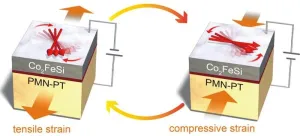(Press-News.org) Researchers have linked a decade-long decline in the blood lead levels of American Indian adults to long-term cardiovascular health benefits, including reduced blood pressure levels and a reduction in a marker associated with hypertrophic cardiomyopathy and heart failure. The research team, supported by the National Institutes of Health, found that adults who had the greatest reductions in blood lead levels saw their systolic blood pressure fall by about 7 mm Hg, an amount comparable to the effects of blood pressure-lowering medication. Lead exposure is known to harm the health of children by damaging the brain and nervous system and slowing growth and development. It has also been associated with increased risks for heart disease in adults. The findings published in the Journal of the American Heart Association.
“This is a huge win for public health, especially since many American Indians can face higher risks for elevated lead levels,” said Anne E. Nigra, Ph.D., the senior study author and an assistant professor of environmental health sciences at Columbia University Mailman School of Public Health, New York City. “Compared to the general U.S. population, American Indian communities experience both a higher burden of cardiovascular disease and elevated metal exposure. We saw that even small decreases in a person’s blood lead levels can have meaningful health outcomes.”
Investigators partnered with 285 American Indian adults in the Strong Heart Family Study, an extension of the Strong Heart Study, the largest and longest study of cardiovascular health outcomes and risk factors among American Indian adults. Participants lived in one of four tribal communities in Arizona, Oklahoma, North Dakota, or South Dakota. The authors explained that features of the built environment can lead to elevated lead exposure in tribal communities. This includes being exposed to lead through well water, local waterways, foods, including canned goods, herbs, and spices, as well as paint and dust.
For this retrospective review, the researchers looked at blood lead levels and blood pressure readings over time. Lead was first measured in blood collected during a 1997-1999 study visit and again in blood collected during a follow-up visit between 2006-2009. During these visits, participants had their blood pressure taken and participated in medical exams that included echocardiographs, a test to assess the heart’s structure and function. To support equal comparisons among participants, researchers controlled for multiple factors, including social variables, including education and income, cardiovascular disease risks, and medical history.
At the start of the study, the average blood lead level was 2.04 µg/dL. Throughout the study, the average blood lead level fell by 0.67 µg/dL, or 33%. The most significant changes occurred in participants with average starting blood lead levels of 3.21 µg/dL and who experienced reductions of about 1.78 µg/dL, or 55%. This drop was linked to a 7 mm Hg reduction in systolic blood pressure.
Nigra and the study authors credit these improvements in large part to public health policies and efforts implemented in recent decades to reduced lead exposure through paint, gasoline, water, plumbing, and canned items. The decline in blood lead levels observed in the study are similar to those seen in the general U.S. population in recent years, but exposure to elevated levels of lead and other metals have been disproportionately higher among American Indians.
“This is a sign that policies and awareness and education campaigns in these communities to reduce blood lead levels are working,” said Mona Puggal, M.P.H., an epidemiologist in the Division of Cardiovascular Sciences at the National Heart, Lung, and Blood Institute (NHLBI). “The reductions in blood pressure are comparable to improvements one sees with lifestyle changes, such as getting 30 minutes of daily exercise, reducing salt intake, or losing weight.”
The investigators noted the importance of also conducting this research in other communities, especially for populations with elevated risks for lead exposure and cardiovascular disease.
“More research needs to be done to determine how environmental agents exacerbate cardiovascular and other diseases, and more needs to be done to improve the environmental health of American Indians,” said Lindsey A. Martin, Ph.D., a health science administrator at the National Institute of Environmental Health Sciences (NIEHS), also part of NIH.
This research was funded by NIEHS and NHLBI.
Study: Lieberman-Cribbin W, Li Z, Lewin M, et al. The contribution of declines in blood lead levels to reductions in blood pressure levels: longitudinal evidence in the Strong Heart Family Study. J Am Heart Assoc. 2024; doi: 10.1161/JAHA.123.031256.
###
About the National Heart, Lung, and Blood Institute (NHLBI): NHLBI is the global leader in conducting and supporting research in heart, lung, and blood diseases and sleep disorders that advances scientific knowledge, improves public health, and saves lives. For more information, visit https://www.nhlbi.nih.gov/.
About the National Institute of Environmental Health Sciences (NIEHS): NIEHS supports research to understand the effects of the environment on human health and is part of the National Institutes of Health. For more information on NIEHS or environmental health topics, visit www.niehs.nih.gov or subscribe to a news list.
About the National Institutes of Health (NIH): NIH, the nation's medical research agency, includes 27 Institutes and Centers and is a component of the U.S. Department of Health and Human Services. NIH is the primary federal agency conducting and supporting basic, clinical, and translational medical research, and is investigating the causes, treatments, and cures for both common and rare diseases. For more information about NIH and its programs, visit https://www.nih.gov/.
NIH...Turning Discovery Into Health
END
Reduced blood lead levels linked to lower blood pressure in American Indians
Reductions correlated with long-term cardiovascular health improvements
2024-01-11
ELSE PRESS RELEASES FROM THIS DATE:
Reduced blood lead levels linked to lower blood pressure
2024-01-11
Through the Strong Heart Family Study, National Institutes of Health-supported researchers found that small declines in blood lead levelswere associated with long-term cardiovascular health improvements in American Indian adults. Participants who had the greatest reductions in blood lead levels saw their systolic blood pressure fall by about 7 mm Hg, an amount comparable to the effects of blood pressure-lowering medication.
The findings as reported from researchers at Columbia ...
Ocean temperatures helped make 2023 the hottest year ever recorded
2024-01-11
A multi-national team of scientists (China, USA, New Zealand, Italy, and France) analyze the temperature of the Earth annually. These scientists have found a fever that increases every year. For the past decade, each year has been hotter than the prior year in the ocean. And there are other changes in the ocean that also matter.
The ocean is an important part of the Earth's climate system – it covers 70% of the planet and absorbs about 90% of the heat from global warming. The ocean helps control the atmosphere – a warmer ocean leads to a warmer and moister atmosphere with wilder weather. The ocean also controls ...
Towards realizing eco-friendly and high-performance thermoelectric materials
2024-01-11
In a new study, environmentally benign inverse-perovskites with high energy conversion efficiency have been reported by Tokyo Tech scientists with potential for practical application as thermoelectric materials (TEMs). Addressing the limitations typically faced with TEMs, such as insufficient energy conversion efficiency and environmental toxicity due to heavy elements, the new TEMs provide a suitable alternative to TEMs based on toxic elements with better thermoelectric properties than conventional eco-friendly TEMs.
Thermoelectric materials (TEMs) capable of converting thermal energy to electrical energy and vice versa have become an essential part of our world, which needs ...
Watching others visibly dislike vegetables might make onlookers dislike them, too
2024-01-11
Humans learn which behaviors pay off and which don’t from watching others. Based on this, we may draw conclusions about how to act – or eat. In the case of the latter, people may use each other as guides to determine what and how much to eat. This is called social modelling and is one of the most powerful social influences on eating behavior.
In a new study, researchers in the UK investigated whether observing others’ facial expressions while eating raw broccoli influenced young women’s liking and desire to ...
Making an important industrial synthesis more environmentally friendly
2024-01-11
Osaka, Japan – Approximately 5% of global carbon emissions are attributable to producing the chemicals that are essential to modern life. Creating a sustainable solution to one chemical reaction in particular – the autoxidation of aldehydes – has challenged researchers for decades.
Now, in a study recently published in Green Chemistry, researchers from Osaka University, Shizuoka Institute of Science & Technology, and collaborating partners have solved this problem. Through reaction kinetics and mathematical ...
Toward efficient spintronic materials
2024-01-11
Controlling the direction of magnetization using low electric field is necessary for developing efficient spintronic devices. In spintronics, properties of an electron’s spin or magnetic moment are used to store information. The electron spins can be manipulated by straining orbital magnetic moments to create a high-performance magnetoelectric effect.
Japanese researchers, including Jun Okabayashi from the University of Tokyo, revealed a strain-induced orbital control mechanism in interfacial multiferroics. In multiferroic material, the magnetic property ...
Study finds hospital surfaces can harbor harmful microbes even after routine disinfection
2024-01-11
Study Finds Hospital Surfaces Can Harbor Harmful Microbes Even After Routine Disinfection
Microbial contamination, including harmful pathogens, was found on bed rails, workstations, and other frequently-touched surfaces
Arlington, Va. — January 11, 2024 — A new study published today in the American Journal of Infection Control (AJIC) reports microbial contamination — including pathogenic and potentially pathogenic bacteria — on high-touch hospital surfaces despite compliance with recommended disinfection protocols. The findings shed light on the persistent challenge of reducing healthcare-associated infections ...
Researchers develop prime editors using Cas12a and circular RNAs in human cells
2024-01-11
In a study published in Nature Biotechnology, GAO Caixia's group from the Institute of Genetics and Developmental Biology of the Chinese Academy of Sciences has developed a series of new prime editors based on the Cas12a protein, further expanding the targeting scope and applications of precision genome editing.
Prime editing (PE) enables precise, targeted DNA insertions, deletions, and replacements. To date, all efficient prime editors have been based on Cas9. However, the Cas9 has certain disadvantages that limit the broad application of prime editors. For example, it is too large, experiences higher levels of off-target editing, and has limited effectiveness ...
A methodology for regulating fuel stratification and improving fuel economy of GCI mode via double main-injection strategy
2024-01-11
Exploring advanced combustion mode with high efficiency and low emissions has been the dream of successive generations of researchers. Conventional diesel engines have high compression ratios thus with thermal efficiencies of 35%–45%, but the diffusion combustion
characteristics of diesel make NOx and soot emissions high. Gasoline compression ignition (GCI) is an advanced combustion mode in the field of internal combustion engines, which combines the advantages of the high efficiency of diesel engines and the low emissions of gasoline engines. Although the GCI mode ...
Exciplex route to white OLEDs: the role of spacer
2024-01-11
Organic light emitting diodes (OLEDs) have matured to commercial level. Yet, their widespread market adoption is hindered due to high costs and complicated device architecture. Researchers are actively exploring innovative device engineering strategies to circumvent these issues.
Narayanan Unni and co-workers have tried to address the above challenges by exploiting a concept called exciplex. Exciplex emission is possible at the interface of two different materials which may not be luminescent themselves. This provides an opportunity to use relatively cheaper materials instead of costly fluorescent or phosphorescent emitter materials. They ...
LAST 30 PRESS RELEASES:
Austrian cow shows first case of flexible, multi-purpose tool use in cattle
Human nasal passages defend against the common cold and help determine how sick we get
Research alert: Spreading drug costs over the year may ease financial burden for Medicare cancer patients
Hospital partnership improves follow up scans, decreases long term risk after aortic repair
Layered hydrogen silicane for safe, lightweight, and energy-efficient hydrogen carrier
Observing positronium beam as a quantum matter wave for the first time
IEEE study investigates the effects of pointing error on quantum key distribution systems
Analyzing submerged fault structures to predict future earthquakes in Türkiye
Quantum ‘alchemy’ made feasible with excitons
‘Revoice’ device gives stroke patients their voice back
USF-led study: AI helps reveal global surge in floating algae
New method predicts asthma attacks up to five years in advance
Researchers publish first ever structural engineering manual for bamboo
National poll: Less than half of parents say swearing is never OK for kids
Decades of suffering: Long-term mental health outcomes of Kurdish chemical gas attacks
Interactional dynamics of self-assessment and advice in peer reflection on microteaching
When aging affects the young: Revealing the weight of caregiving on teenagers
Can Canada’s health systems handle increased demand during FIFA World Cup?
Autistic and non-autistic faces may “speak a different language” when expressing emotion
No clear evidence that cannabis-based medicines relieve chronic nerve pain
Pioneering second-order nonlinear vibrational nanoscopy for interfacial molecular systems beyond the diffraction limit
Bottleneck in hydrogen distribution jeopardises billions in clean energy
Lung cancer death rates among women in Europe are finally levelling off
Scientists trace microplastics in fertilizer from fields to the beach
The Lancet Obstetrics, Gynecology, & Women’s Health: Taking paracetamol during pregnancy does not increase risk of autism, ADHD or intellectual disabilities, confirms new gold-standard evidence review
Taking paracetamol during pregnancy does not increase risk of autism, ADHD or intellectual disabilities
Harm reduction vending machines in New York State expand access to overdose treatment and drug test strips, UB studies confirm
University of Phoenix releases white paper on Credit for Prior Learning as a catalyst for internal mobility and retention
Canada losing track of salmon health as climate and industrial threats mount
Molecular sieve-confined Pt-FeOx catalysts achieve highly efficient reversible hydrogen cycle of methylcyclohexane-toluene
[Press-News.org] Reduced blood lead levels linked to lower blood pressure in American IndiansReductions correlated with long-term cardiovascular health improvements







